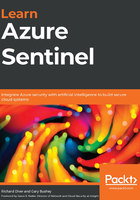
Cloud platform integrations
One of the key reasons you might be planning to deploy Azure Sentinel is to manage the security for your cloud platform deployments. Instead of sending logs from the cloud provider to an on-premises SIEM solution, you will likely want to keep that data off your local network, so as to save on bandwidth usage and storage costs.
Let's now take a look at how some of these platforms can be integrated with Azure Sentinel.
Integrating with AWS
AWS provides API access to most features across the platform, which enables Azure Sentinel to be a rich integration solution. The following list provides some of the common resources that should be integrated with Azure Sentinel if enabled in the AWS account(s):
- AWS Cloud Trail logs provide insights into AWS user activities, including failed sign-in attempts, IP addresses, regions, user agents, and identity types, as well as potential malicious user activities with assumed roles.
- AWS Cloud Trail logs also provide network-related resource activities, including the creation, update, and deletion of security groups, network access control lists (ACLs) and routes, gateways, elastic load balancers, Virtual Private Cloud (VPC), subnets, and network interfaces.
Some resources deployed within the AWS account(s) can be configured to send logs directly to Azure Sentinel (such as Windows Event Logs). You may also deploy a log collector (Syslog, CEF, or LogStash) within the AWS account(s) to centralize the log collection, the same as you would for a private data center.
Integrating with Google Cloud Platform (GCP)
GCP also provides API access to most features. However, there isn't currently an out-of-the-box solution to integrate with Azure Sentinel. If you are managing a GCP instance and want to use Azure Sentinel to secure it, you should consider the following options:
- REST API—this feature is still in development; when released, it will allow you to create your own investigation queries.
- Deploy a CASB solution that can interact with GCP logs, control session access, and forward relevant information to Azure Sentinel.
- Deploy a log collector such as Syslog, CEF, or LogStash. Ensure that all deployed resources can forward their logs via the log collector to Azure Sentinel.
Integrating with Microsoft Azure
The Microsoft Azure platform provides direct integration with many Microsoft security solutions, and more are being added every month:
- Azure AD, for collecting audit and sign-in logs to gather insights about app usage, conditional access policies, legacy authentication, self-service password reset usage, and management of users, groups, roles, and apps.
- Azure AD Identity Protection, which provides user and sign-in risk events and vulnerabilities, with the ability to remediate risk immediately.
- Azure ATP, for the protection of Active Directory domains and forests.
- Azure Information Protection, to classify and optionally protect sensitive information.
- Azure Security Center, which is a CWPP for Azure and hybrid deployments.
- DNS Analytics, to improve investigations for clients that try to resolve malicious domain names, talkative DNS clients, and other DNS health-related events.
- Microsoft Cloud App Security, to gain visibility into connected cloud apps and an analysis of firewall logs.
- Microsoft Defender ATP, a security platform designed to prevent, detect, investigate, and respond to advanced threats on Windows, Mac, and Linux computers.
- Microsoft Web App Firewall (WAF), to protect applications from common web vulnerabilities.
- Microsoft Office 365, to provide insights into ongoing user activities, such as file downloads, access requests, changes to group events, and mailbox activity.
- Microsoft Threat Intelligence Platforms, for integration with the Microsoft Graph Security API data sources: This connector is used to send threat indicators from Microsoft and third-party threat intelligence platforms.
- Windows Firewall, if installed on your servers and desktop computers (recommended).
Microsoft makes many of these log sources available to Azure Sentinel for no additional log storage charges, which could provide a significant cost saving when considering other SIEM tool options.
Other cloud platforms will provide similar capabilities, so review the options as part of your ongoing due diligence across your infrastructure and security landscape.
Whichever cloud platforms you choose to deploy, we encourage you to consider deploying a suitable CWPP solution to provide additional protections against misconfiguration and compliance violations. The CWPP can then forward events to Azure Sentinel for central reporting, alerting, and remediation.